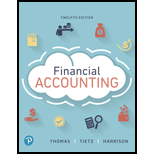
Financial Accounting (12th Edition) (What's New in Accounting)
12th Edition
ISBN: 9780134725987
Author: C. William Thomas, Wendy M. Tietz, Walter T. Harrison Jr.
Publisher: PEARSON
expand_more
expand_more
format_list_bulleted
Concept explainers
Question
Chapter 4, Problem 3QC
To determine
To find: The correct option, the option which is the type of fraud mentioned in the situation
Expert Solution & Answer
Want to see the full answer?
Check out a sample textbook solution
Students have asked these similar questions
Answer this without using chatgtp or AI
Nicole is a calendar-year taxpayer who accounts for her business using the cash method. On average, Nicole sends out bills for about $12,000 of her services on the first of each month. The bills are due by the end of the month, and typically 70 percent of the bills are paid on time and 98 percent are paid within 60 days.
a. Suppose that Nicole is expecting a 2 percent reduction in her marginal tax rate next year. Ignoring the time value of money, estimate the tax savings for Nicole if she postpones mailing the December bills until January 1 of next year.
General accounting
Chapter 4 Solutions
Financial Accounting (12th Edition) (What's New in Accounting)
Ch. 4 - Prob. 1QCCh. 4 - Prob. 2QCCh. 4 - Prob. 3QCCh. 4 - Prob. 4QCCh. 4 - Prob. 5QCCh. 4 - Prob. 6QCCh. 4 - Prob. 7QCCh. 4 - Why does cash require some specific internal...Ch. 4 - Prob. 9QCCh. 4 - Prob. 10QC
Ch. 4 - Prob. 11QCCh. 4 - Prob. 12QCCh. 4 - Prob. 4.1ECCh. 4 - Prob. 4.1SCh. 4 - Prob. 4.2SCh. 4 - (Learning Objective 2: Describe objectives and...Ch. 4 - Prob. 4.4SCh. 4 - (Learning Objective 2: Explain the objectives and...Ch. 4 - (Learning Objective 3: Evalue internal controls...Ch. 4 - Prob. 4.7SCh. 4 - Prob. 4.8SCh. 4 - Prob. 4.9SCh. 4 - Prob. 4.10SCh. 4 - Prob. 4.11SCh. 4 - Prob. 4.12SCh. 4 - Prob. 4.13SCh. 4 - Prob. 4.14SCh. 4 - Prob. 4.15AECh. 4 - Prob. 4.16AECh. 4 - Prob. 4.17AECh. 4 - Prob. 4.18AECh. 4 - Prob. 4.19AECh. 4 - Prob. 4.20AECh. 4 - Prob. 4.21AECh. 4 - Prob. 4.22BECh. 4 - Prob. 4.23BECh. 4 - Prob. 4.24BECh. 4 - (Learning Objectives 1, 2, 3: Describe fraud and...Ch. 4 - Prob. 4.26BECh. 4 - Prob. 4.27BECh. 4 - Prob. 4.28BECh. 4 - Prob. 4.29QCh. 4 - Prob. 4.30QCh. 4 - Prob. 4.31QCh. 4 - Prob. 4.32QCh. 4 - Prob. 4.33QCh. 4 - Prob. 4.34QCh. 4 - Prob. 4.35QCh. 4 - Prob. 4.36QCh. 4 - Prob. 4.37QCh. 4 - Prob. 4.38QCh. 4 - Prob. 4.39QCh. 4 - Prob. 4.40QCh. 4 - Prob. 4.41APCh. 4 - Prob. 4.42APCh. 4 - Prob. 4.43APCh. 4 - Prob. 4.44APCh. 4 - Prob. 4.45BPCh. 4 - (Learning Objectives 2, 3: Explain the objectives...Ch. 4 - (Learning Objective 3: Evaluate internal controls)...Ch. 4 - Prob. 4.48BPCh. 4 - Prob. 4.49CEPCh. 4 - Prob. 4.50CEPCh. 4 - Prob. 4.51SCCh. 4 - Prob. 4.52DCCh. 4 - Prob. 4.53DCCh. 4 - Prob. 4.54EICCh. 4 - Prob. 1FFCh. 4 - Prob. 1FA
Knowledge Booster
Learn more about
Need a deep-dive on the concept behind this application? Look no further. Learn more about this topic, accounting and related others by exploring similar questions and additional content below.Similar questions
arrow_back_ios
SEE MORE QUESTIONS
arrow_forward_ios
Recommended textbooks for you
 Auditing: A Risk Based-Approach (MindTap Course L...AccountingISBN:9781337619455Author:Karla M Johnstone, Audrey A. Gramling, Larry E. RittenbergPublisher:Cengage Learning
Auditing: A Risk Based-Approach (MindTap Course L...AccountingISBN:9781337619455Author:Karla M Johnstone, Audrey A. Gramling, Larry E. RittenbergPublisher:Cengage Learning Auditing: A Risk Based-Approach to Conducting a Q...AccountingISBN:9781305080577Author:Karla M Johnstone, Audrey A. Gramling, Larry E. RittenbergPublisher:South-Western College Pub
Auditing: A Risk Based-Approach to Conducting a Q...AccountingISBN:9781305080577Author:Karla M Johnstone, Audrey A. Gramling, Larry E. RittenbergPublisher:South-Western College Pub

Auditing: A Risk Based-Approach (MindTap Course L...
Accounting
ISBN:9781337619455
Author:Karla M Johnstone, Audrey A. Gramling, Larry E. Rittenberg
Publisher:Cengage Learning

Auditing: A Risk Based-Approach to Conducting a Q...
Accounting
ISBN:9781305080577
Author:Karla M Johnstone, Audrey A. Gramling, Larry E. Rittenberg
Publisher:South-Western College Pub
